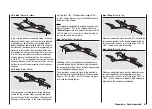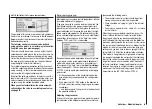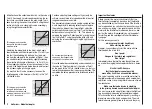
75
ons, fl uctuations in system rotational speed and other in-
fl uences.
However, in an autorotation descent the main rotor is not
driven by the motor, and therefore there is no torque ef-
fect for which compensation is required, i.e. which the
tail rotor would have to correct. For this reason all the
appropriate mixers are automatically switched off in au-
torotation mode.
However, the basic tail rotor setting has to be different
for autorotation, as the compensatory thrust described
above is no longer required.
Stop the motor and place the helicopter horizontal. With
the transmitter and receiving system switched on, select
the »
Autorotation
« fl ight phase. Fold both tail rotor bla-
des down and change the blade pitch angle to zero de-
grees using the “Tail rotor” menu. Viewed from the rear,
the tail rotor blades should now be parallel to each other.
Depending on the friction and running resistance of the
gearbox, you may fi nd that the fuselage still yaws slight-
ly in an autorotation descent. If necessary, the relatively
slight torque which causes this effect must then be cor-
rected by adjusting the tail rotor blade pitch angle. This
value will always be a small fi gure between zero de-
grees and a pitch angle opposed to the direction of tail
rotor pitch required for normal fl ight.
Heli mixer / Autorotation – Model helicopter
Summary of Contents for MX-16S
Page 1: ...1...
Page 17: ...17...
Page 31: ...31 Fixed wing models Installation and connections...
Page 35: ...35 Program description Reserving a new memory...
Page 47: ...47 Base settings Model helicopter...
Page 83: ...83 Fail safe...
Page 89: ...89 Programming examples Fixed wing model...
Page 109: ...109 Programming examples Model helicopter...
Page 112: ...112 112...
Page 116: ...116...
















































